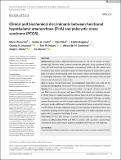Files in this item
Clinical and biochemical discriminants between Functional Hypothalamic Amenorrhoea (FHA) and Polycystic Ovary Syndrome (PCOS)
Item metadata
| dc.contributor.author | Phylactou, Maria | |
| dc.contributor.author | Clarke, Sophia A. | |
| dc.contributor.author | Patel, Bijal | |
| dc.contributor.author | Baggaley, Caitlin | |
| dc.contributor.author | Jayasena, Channa N. | |
| dc.contributor.author | Kelsey, Tom | |
| dc.contributor.author | Comninos, Alexander N. | |
| dc.contributor.author | Dhillo, Waljit S. | |
| dc.contributor.author | Abbara, Ali | |
| dc.date.accessioned | 2021-03-23T17:30:04Z | |
| dc.date.available | 2021-03-23T17:30:04Z | |
| dc.date.issued | 2021-08 | |
| dc.identifier | 271694140 | |
| dc.identifier | e8bfea36-e446-413b-a603-8c0eec77de46 | |
| dc.identifier | 85100221592 | |
| dc.identifier | 000608717600001 | |
| dc.identifier.citation | Phylactou , M , Clarke , S A , Patel , B , Baggaley , C , Jayasena , C N , Kelsey , T , Comninos , A N , Dhillo , W S & Abbara , A 2021 , ' Clinical and biochemical discriminants between Functional Hypothalamic Amenorrhoea (FHA) and Polycystic Ovary Syndrome (PCOS) ' , Clinical Endocrinology , vol. 95 , no. 2 , pp. 239-252 . https://doi.org/10.1111/cen.14402 | en |
| dc.identifier.issn | 1365-2265 | |
| dc.identifier.other | ORCID: /0000-0002-8091-1458/work/85855112 | |
| dc.identifier.uri | https://hdl.handle.net/10023/21695 | |
| dc.description | Funding: This work is supported by grants from the National Institute of Health Research (NIHR) and supported by the NIHR/Wellcome Trust Imperial Clinical Research Facility and the NIHR Imperial Biomedical Research Centre. The Section of Endocrinology and Investigative Medicine was funded by grants from the MRC, BBSRC and NIHR and was supported by the NIHR Biomedical Research Centre Funding Scheme. SAC was supported an NIHR Academic Clinical Lectureship. CNJ was supported by an NIHR Post-Doctoral Fellowship. ANC was supported by the NHS. WSD was supported by an NIHR Research Professorship NIHR-RP-2014-05-001. AA was supported by an NIHR Clinician Scientist Award CS-2018-18-ST2-002. | en |
| dc.description.abstract | Background Secondary oligo/amenorrhoea occurs in 3‐5% of women of reproductive age. The two most common causes are Polycystic Ovary Syndrome (PCOS) (2‐13%) and Functional Hypothalamic Amenorrhoea (FHA) (1‐2%). Whilst both conditions have distinct pathophysiology and their diagnosis is supported by guidelines, in practice, differentiating these two common causes of menstrual disturbance is challenging. Moreover, both diagnoses are qualified by the need to first exclude other causes of menstrual disturbance. Aim To review clinical, biochemical and radiological parameters that could aid the clinician in distinguishing PCOS and FHA as a cause of menstrual disturbance. Results FHA is uncommon in women with BMI >24 kg/m2, whereas both PCOS and FHA can occur in women with lower BMIs. AMH levels are markedly elevated in PCOS, however milder increases may also be observed in FHA. Likewise, polycystic ovarian morphology (PCOM) is more frequently observed in FHA than in healthy women. Features that are differentially altered between PCOS and FHA include LH, androgen, insulin, AMH, and SHBG levels, endometrial thickness, and cortisol response to CRH. Other promising diagnostic tests with the potential to distinguish these two conditions pending further study include assessment of 5‐alpha reductase activity, leptin, INSL3, kisspeptin, and inhibin‐B levels. Conclusion Further data directly comparing the discriminatory potential of these markers to differentiate PCOS and FHA in women with secondary amenorrhoea would be of value in defining an objective probability for PCOS or FHA diagnosis. | |
| dc.format.extent | 739664 | |
| dc.language.iso | eng | |
| dc.relation.ispartof | Clinical Endocrinology | en |
| dc.subject | Functional hypothalamic amenorrhoea | en |
| dc.subject | Oligo/amenorrhoea | en |
| dc.subject | Polycystic ovary syndrome (PCOS) | en |
| dc.subject | QD Chemistry | en |
| dc.subject | QH301 Biology | en |
| dc.subject | RG Gynecology and obstetrics | en |
| dc.subject | DAS | en |
| dc.subject.lcc | QD | en |
| dc.subject.lcc | QH301 | en |
| dc.subject.lcc | RG | en |
| dc.title | Clinical and biochemical discriminants between Functional Hypothalamic Amenorrhoea (FHA) and Polycystic Ovary Syndrome (PCOS) | en |
| dc.type | Journal item | en |
| dc.contributor.institution | University of St Andrews. School of Computer Science | en |
| dc.contributor.institution | University of St Andrews. Centre for Interdisciplinary Research in Computational Algebra | en |
| dc.identifier.doi | 10.1111/cen.14402 | |
| dc.description.status | Peer reviewed | en |
This item appears in the following Collection(s)
Items in the St Andrews Research Repository are protected by copyright, with all rights reserved, unless otherwise indicated.

